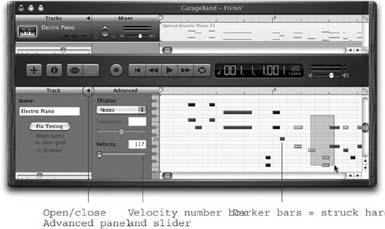Velocity, Pedaling, and Other MIDI Data
As you’ve probably started to gather by now, there’s more to a musical performance than deciding which notes to play when. A keyboard player, for example, adds nuance and interest to a performance using a number of other tools. The velocity of the playing (how hard each key is struck), the pedaling (using a sustain pedal connected to the keyboard), and the control wheels (pitch and modulation) can all affect the way the music sounds.
GarageBand records all of this information as you play and lets you edit it later. The key to viewing and editing these kinds of MIDI information is the Advanced panel of the Track Editor (Figure 26-13).

Figure 26-13. To edit key velocity, first select the note or notes you want to affect, as shown here. Then, change their velocity using either the Velocity number box—type in a new number from 0 to 127—or the slider beneath it.
Editing Key Velocity
Key velocity is a digital record of how hard you pressed each key when you recorded a MIDI region. On some instruments, greater key velocity just means “louder,” as it does on a piano. But in others, greater velocity means “more vibrato,” “crunchier sound,” and so on.
Key velocity is measured on a scale of 0 to 127, which may not seem like an especially logical scale to you, but (because it’s a power of 2) it’s very convenient for the Mac to understand. In any case, a velocity ...
Get iLife '04: The Missing Manual now with the O’Reilly learning platform.
O’Reilly members experience books, live events, courses curated by job role, and more from O’Reilly and nearly 200 top publishers.

